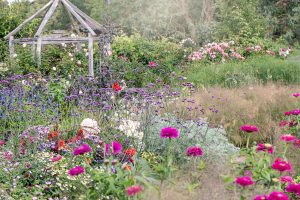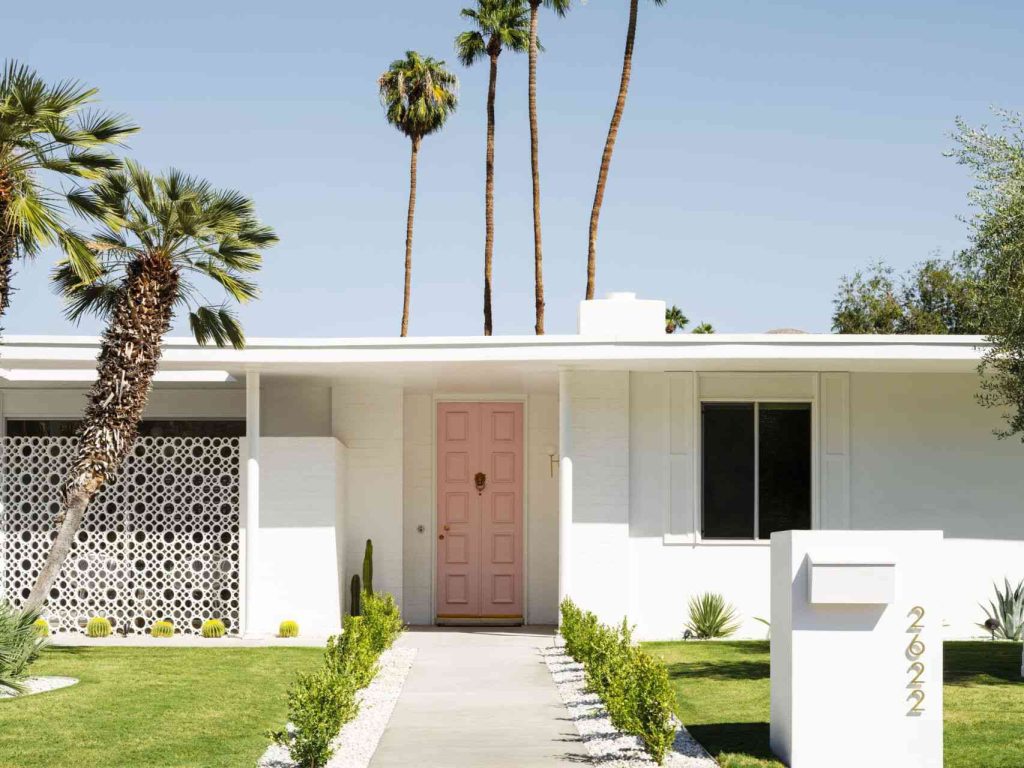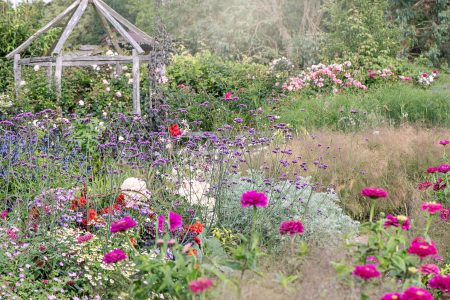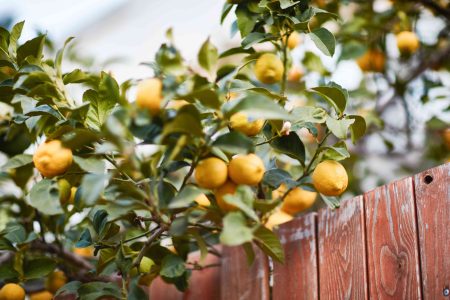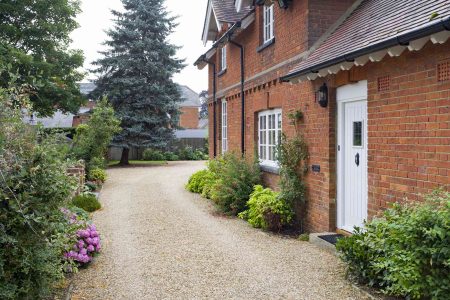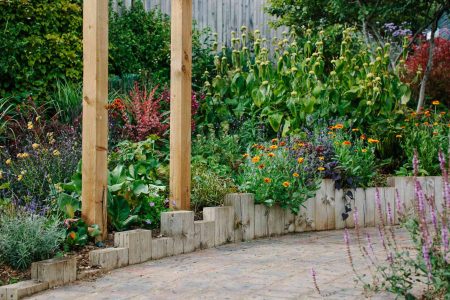Between labor and material costs, a landscaping bill adds up fast. However, there are several changes you can tackle yourself in just a weekend for around $100. If you’re up for some slightly more expensive and involved changes, you might even yield a return on your investment due to lower maintenance costs and a property value increase. So, take inspiration from these front yard landscapes and then head outside with a shovel in tow.
-
01
of 22Use Large Flower Pots as Landscaping Features
Oversized flower pots placed in areas like your front porch and driveway can make just as much impact as a large flower bed. Container gardening also requires fewer tools and less soil. Go for common landscaping plants like arborvitae, bamboo, feather reed grass, boxwood, and elephant ears since they all thrive in large containers.
Continue to 2 of 22 below. -
02
of 22Plant Additional Flower Beds Around Existing Features
Not every flower bed needs a dedicated retaining wall. If you want to add extra plants to your front yard, you don’t need to build additional features.
For example, you can simply plant a row of evergreens alongside an already existing walkway to give it a sense of structure and intention. Line the area around your newly added plants with mulch to create a bit of contrast and to keep weeds and grass from growing around them.
Continue to 3 of 22 below. -
03
of 22Opt for Pea Gravel and Stepping Stones Over Concrete
Pea gravel is cheaper and a more stylish alternative to concrete. A pea gravel patio or walkway is also a fairly easy DIY, so it’ll save you on any labor costs. If you still want a smooth surface to walk on leading up to your house, just add stepping stones to the mix.
Continue to 4 of 22 below. -
04
of 22Just Stick With Pavers
If your yard already has lush grass on it, there’s no sense in covering it with gravel or concrete to make a walkway. A few affordable pavers will make a perfect spot for your feet to land.
Continue to 5 of 22 below. -
05
of 22Edge Your Driveway With Pavers or Reclaimed Bricks
It’s often the small details that make a front yard picture-perfect. We love the simple addition of the stone pavers along the driveway in this design by Kate Marker Interiors.
If you have a long driveway, you can always check for free or affordable reclaimed brick on Facebook Marketplace to keep the cost down. You might have to source your brick from multiple sellers, but sticking with the same color will keep the design cohesive.
Continue to 6 of 22 below. -
06
of 22Keep Your Plant Choices Simple
Sticking with just one to two types of plants in your flower beds can help keep things affordable. Plus, you may qualify for a bulk discount if you purchase several of the same plants.
Choosing one evergreen and one blooming bush creates a sense of texture and variety. Options like hydrangeas and boxwood grow large and fill more space as they mature.
Continue to 7 of 22 below. -
07
of 22Go With an Xeriscape if Your Region Is Drought-Prone
Xeriscape landscaping involves choosing plants that thrive in desert-like conditions. This landscaping method is ideal for regions that experience little rainfall and lots of sunlight.
Drought-tolerant and desert plants are less likely to die in regions like this, which means you are less likely to have to re-buy them mid-season. Additionally, choosing plants that require less water can save you a lot of money in the case of a water surcharge during a drought.
Continue to 8 of 22 below. -
08
of 22Start Native Plants From Seed
Even if you don’t live in a drought-prone region, it’s still important to think about what type of plants will do best in your front yard. Otherwise, you might be wasting your money on a plant that won’t make it to late summer.
Choosing native plants is a great way to do this. Blooming native plants are great for your local ecosystem since they provide nectar for pollinators and attract bugs for birds to eat. Certain natives are very easy to grow from seed, which is a cheaper alternative to purchasing starter plants.
Continue to 9 of 22 below. -
09
of 22Stick With Perennials
Perennials are plants that are cold-hardy and will return in the spring year after year. With proper care, they are pretty much just a one-time investment.
Continue to 10 of 22 below. -
10
of 22Fill in Gaps With Landscaping Rocks
If you already have some large landscaping rocks on hand, moving them into a flowerbed in the place of a missing plant is a quick and easy fix. A few medium landscaping rocks run similar in cost to a large landscaping plant.
Continue to 11 of 22 below. -
11
of 22Mulch Your Large Garden Beds
While gravel is a chic, long-lasting option for covering your garden beds, mulch requires less upfront investment. Its lower cost also makes it an especially great option if you have extra large garden beds that you need to cover. Just keep in mind that you may need to replace the mulch within one year to keep it looking its best.
Continue to 12 of 22 below. -
12
of 22Spruce Up Your Landscaping Beds With Multi-Colored Gravel
If your garden beds contain mulch and you’re ready for an upgrade, topping it off with a layer of multi-colored gravel can elevate the overall look. Plus, gravel lasts longer than mulch, so you’ll get more use out of your purchase.
You can also add a new color to your already-existing gravel to add some intrigue. Just use a rake to mix the two colors together.
Continue to 13 of 22 below. -
13
of 22Guide Your Eyes to the Door With Plants
If you have a front door that you love, you can draw even more attention to it by lining either side of your walkway with small shrubs. This will direct your gaze straight to the door and immediately make guests feel like they’re already welcomed inside. You can still do this even if you have a walkway that curves or angles before reaching the door.
Continue to 14 of 22 below. -
14
of 22Select Plants That Look Good Year-Round
Certain landscaping plants look amazing in every season. Evergreens are a no-brainer if you want greenery in your yard even in the dead of winter. Additionally, hydrangeas have a long blooming season, and their dried clusters look beautiful on the bushes throughout the winter.
Continue to 15 of 22 below. -
15
of 22Up Your Curb Appeal by Planting at the Curb
When landscaping your front yard, you don’t have to limit yourself to garden beds only along the edge of your house. Adding plants by your sidewalk will make it a pleasant path for all your neighbors to stroll.
Continue to 16 of 22 below. -
16
of 22Create Sculptural Lawn Art
Planting flowers isn’t the only way to add color and interest to your front yard. If you have a free weekend, you could DIY some sculptural lawn art using materials from the hardware store, like cylinder pipes and paint.
Continue to 17 of 22 below. -
17
of 22Plant Tulips for Early Spring Cheer
Tulip bulbs are very affordable landscaping plants. They are among some of the first plants to bloom in the spring, so they provide a nice touch to your lawn while you’re waiting for your other landscaping plants to flourish after a long winter.
Tulip bulbs last and re-bloom for several years; certain modern varieties can survive in the ground for longer than a decade.
Continue to 18 of 22 below. -
18
of 22Add Just One New Row of Plants at Time
Start slow if you’re working with a blank canvas on your landscaping. Adding just one new row of plants once a year can keep the feelings of overwhelm at bay and make your plant budget seem more manageable.
Continue to 19 of 22 below. -
19
of 22Let Vines Climb
Vining plants quickly take off from a small, affordable starter or even seed. A retaining wall or short front yard fence makes an excellent surface for the vines to sprawl.
Continue to 20 of 22 below. -
20
of 22Fill Your Garden Beds With No-Prune Shrubs
Keeping up with trimming shrubs is a chore, and outsourcing this task might be costly. Certain evergreen shrubs, like Gem Box Ink Berry Holly, require no trimming or pruning.
Continue to 21 of 22 below. -
21
of 22Go With Gardens Over Grass
This design by @ladylandscape proves that you don’t need a lawn of pristine grass for a beautiful front yard. Filling your lawn with grass presents an upfront cost but also a maintenance cost.
Turf grass isn’t native to North America, so you’ll need to water it to keep it looking green. With a garden, you can often get by with just letting the rain do its thing. You can start your garden small and by seed to keep the cost low.
Continue to 22 of 22 below. -
22
of 22Keep Your Garden Bed Small
If you’re on a budget, adopt a quality-over-quantity mindset regarding your garden bed. If you limit the square footage of your bed, you can opt for higher-end plants like roses and pea gravel.
Read the full article here



